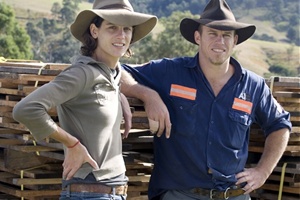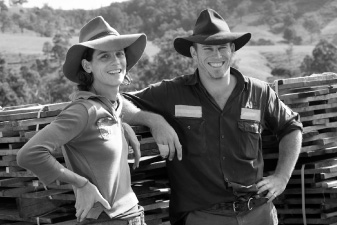Alternative way to sustain the forests
-----------------
IF you hear the term sustainable forestry, you may well associate it with tree plantations.
It is fairly common knowledge that environmental groups want to put a stop to old-growth logging, with large plantations seen as the main alternative.
(An old-growth forest is one that has never been logged.)
The trouble with large plantations is that they are monocultures, therefore lacking biodiversity, with all the problems of traditional farming such as fertiliser use, insecticide use and so on.
Another alternative is farm forestry as practised by Australian Sustainable Timbers.
This is a small company run by Annabel Kater and James Felton-Taylor, from Islington.
Annabel has a Master of Forestry degree and James has a Bachelor of Environmental Science degree. Both have plenty of experience in forestry management, including pivotal roles with the Hunter Farm Forestry Network.
As well as owning their own forest near the Barrington Tops, they work with other landholders to help them begin the long journey of restoring their forests to as near a pristine condition as possible, with a view to harvesting top-quality timber in a sustainable way.
But first some history.
If you look around the Hunter (or most of eastern Australia), you won’t find much old-growth forest.
Almost all our forests have been logged during the past 150 years, with the biggest trees removed.
 What is left is called regrowth forest, usually a mess of smaller trees with a fraction of the biodiversity that the original forest would have had.
What is left is called regrowth forest, usually a mess of smaller trees with a fraction of the biodiversity that the original forest would have had.
It is the older trees, now mostly removed, that have the hollows needed for birds and other animals.
Regrowth forest, as you might see on many farms, especially if there is some hilly country, might have 1000 trees per hectare.
But old-growth forest would have had something like 60 to 100 trees per hectare.
In other words old-growth forest had a relatively small number of very large trees, with a complex understorey and, of course, a wide variety of other plants and animals.
Working under government laws like the Native Vegetation Act and the much more stringent Forest Stewardship Council guidelines, Annabel and James help farmers restore their forests while generating an income from sustainable forestry.
The process
- The first step is a site visit, where Annabel and James inspect the forest and give the landholder a basic idea of its suitability for farm forestry.
- If suitable, the second step is a detailed inventory of the forest.
- From this, a forestry management plan is written.
- Finally, the work of management can begin, which usually includes carefully thinning the forest to help it return to its former glory.
Australian Sustainable Timbers is certified by the international Forest Stewardship Council so the timber harvested can be sold as FSC-certified.
Indeed, FSC certification is now mandatory for some applications (such as in Green Star buildings).
Typical timber uses are for flooring, decking and high-quality features in buildings.
Annabel and James have their own sawmill in the Upper Hunter and other equipment needed to harvest the logs.
A typical forest they manage for landholders would be about 80 hectares (200 acres) in size, with 40 hectares the smallest and 1000 hectares the largest.
Of course a forest doesn’t grow overnight, so landholders are making a long-term commitment when they sign up for FSC-certified forestry.
Indeed, they won’t see the forest return to its old-growth glory in their lifetimes. Yet they have the satisfaction of knowing their land is improving every day, increasing in value while providing some income through sustainable logging. Visit australiansustainabletimbers.com.
---------------

